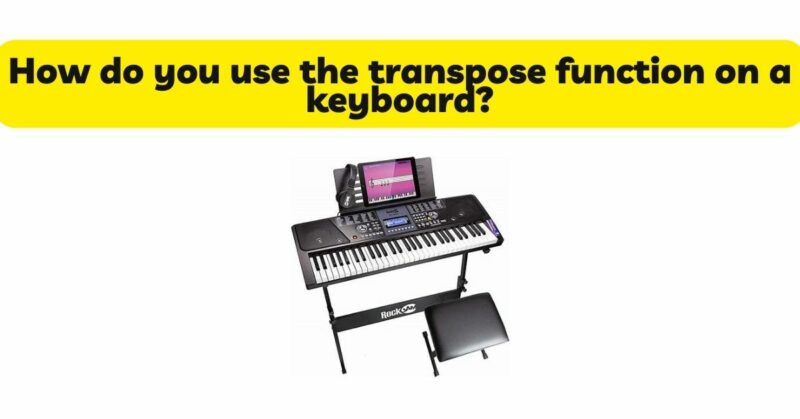The transpose function on a keyboard is a powerful tool that allows musicians to easily shift the pitch of their instrument without having to learn new fingerings or chord shapes. This functionality is particularly useful for adapting songs to different keys, accommodating vocal ranges, or playing along with other musicians. In this article, we will provide a detailed guide on how to effectively use the transpose function on a keyboard, exploring the practical applications, step-by-step instructions, and useful tips to enhance your musical adaptability.
- Understanding the Transpose Function: The transpose function on a keyboard enables you to shift the pitch of the instrument up or down by a specified number of steps or semitones. It essentially allows you to change the key in which you are playing without altering the finger positions or chord shapes. This flexibility is invaluable for musicians in various scenarios, including adapting songs to different keys, matching the vocal range of a singer, or playing in harmony with other instruments.
- Accessing the Transpose Function: The method of accessing the transpose function may vary depending on the keyboard model, but it is typically straightforward. Look for a dedicated transpose button or a menu option on the keyboard’s control panel. Some keyboards may require accessing a settings menu to find the transpose function. Refer to the keyboard’s user manual for specific instructions on accessing the transpose feature.
- Selecting the Transposition Value: Once you have accessed the transpose function, you will need to select the desired transposition value. This value represents the number of steps or semitones by which you want to shift the pitch. Common transposition values range from -12 to +12 semitones, covering a complete octave in both upward and downward directions. Experiment with different transposition values to achieve the desired key change.
- Adjusting the Transposition: Using the keyboard’s controls or buttons, adjust the transposition value to the desired setting. Increase the value to transpose the pitch higher or decrease it to transpose the pitch lower. For example, if you want to transpose a song from the key of C to the key of D, you would typically increase the transposition value by two semitones to achieve the desired effect.
- Transposing Simple Melodies: To practice using the transpose function, start with simple melodies in a key you are familiar with. Play the melody using the original finger positions and then transpose it to a different key using the transpose function. Pay attention to maintaining the same intervals and relationships between the notes. This exercise will help you develop a sense of how transpositions affect the overall sound and feel of the melody.
- Transposing Chords and Progressions: Once you are comfortable transposing melodies, progress to transposing chords and progressions. Play a chord progression in a particular key and then transpose the entire progression using the transpose function. Pay attention to how the chord voicings and relationships change when transposed to different keys. This practice will enhance your ability to transpose complex musical arrangements accurately.
- Accommodating Vocal Ranges: One of the primary applications of the transpose function is accommodating vocal ranges. When accompanying a vocalist, it is crucial to transpose the song to a key that suits their vocal range and comfort. Communicate with the vocalist to determine the most suitable key, and then use the transpose function to shift the song accordingly. This ensures that the vocalist can sing comfortably without straining their voice.
- Playing with Other Instruments: The transpose function is also useful when playing along with other instruments that may be in different keys. Whether you are jamming with a guitarist, joining a band, or participating in a musical ensemble, using the transpose function allows you to match the pitch of your keyboard to the other instruments. This ensures that all musicians can play in the same key, maintaining harmony and synchronization.
- Experimenting with Creative Transpositions: Beyond practical applications, the transpose function can be a creative tool for exploration and experimentation. By transposing songs to different keys, you can discover unique musical possibilities and create fresh arrangements. Try transposing well-known songs to unexpected keys and observe how it transforms the mood and character of the music. This creative approach can lead to new interpretations and personalized performances.
- Limitations and Considerations: While the transpose function on a keyboard offers great flexibility, it is essential to be aware of its limitations. Extreme transpositions, particularly beyond the available transposition range of the keyboard, may result in notes being played outside the instrument’s range or undesirable tonal characteristics. Choose appropriate transposition values that suit the instrument’s capabilities and the musical context.
Additionally, when using the transpose function, be mindful of the overall sound and balance of the music. Extreme transpositions can affect the timbre and clarity of the instrument, potentially compromising the quality of the performance. Use transposition judiciously and consider the overall musical arrangement and instrument combinations.
Conclusion: The transpose function on a keyboard provides musicians with a powerful tool for adapting music to different keys, accommodating vocal ranges, and playing in harmony with other instruments. By following the step-by-step instructions outlined in this article, you can effectively use the transpose function and enhance your musical adaptability. Whether you are a beginner or an experienced player, mastering the transpose function opens up a world of possibilities and ensures that you can confidently tackle songs in any key. Embrace the versatility of the transpose function and elevate your musical performances to new heights.


